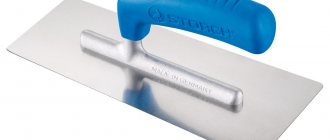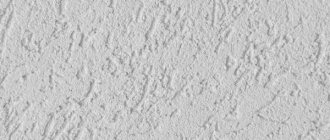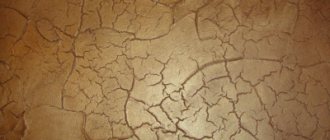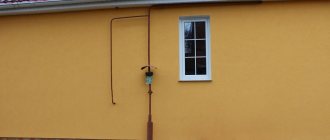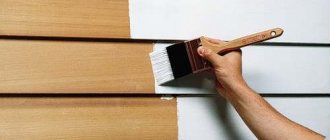When working with decorative plasters, an important role is played by the choice of the right tool and its condition. Expensive material, for example, Venetian plaster, also requires high-quality application. In this article we will talk about how to choose a trowel for a “Venetian” and how to care for the tool during work so that it does not ink or scratch the coating.
in the photo there is a crown. trowel
What is a trowel
The instrument, whose name comes from the German language (kelle), is called a trowel in Russian. You can read more about the definition of trowel on Wikipedia. The tool is designed to perform many operations related to the application and formation of a solution. You can, for example, measure the required amount of bulk components and mix the solution. Having scooped the mixture with a trowel or applied it to a spatula with a spatula, it is applied to the base using this universal tool.
The smooth, straight side edges of the trowel make it possible to pick up excess mixture from the wall surface. A flat (concave or convex) plate is used to level the mortar layer. With a trowel you can grout or create a decorative relief from the surface layer of the plaster mass.
Selecting tools for work
If you still decide to try your hand at creating Venetian plaster, then you must first prepare everything you need for the job. The most important thing is to purchase and prepare tools. You will need a steel float to level and float the mortar. The width of the grater should be approximately 20-25 cm. You will need spatulas, but not simple ones, but a special shape with rounded edges and a perfectly smooth polished surface on which nicks and scratches are unacceptable. For work, it is more convenient to use several spatulas of different widths. You will also need different brushes (flat, round, oval and rectangular paint brushes). Brushes should have stiff bristles.
In addition, the work will require the use of a tape measure, a level, a long ruler, a sanding float, and sandpaper.
Device and characteristics
The main parts of the trowel are a lamellar spatula, a handle securely attached to the base, and a handle mounted on the handle. Each of the parts in various modifications of the tool has its own shape and features. They depend on the type of operations for which the model is intended.
The main shapes of the blades are:
- triangular;
- trapezoidal;
- rectangular;
- diamond-shaped;
- teardrop-shaped;
- oval.
Each shape can have its own characteristics: rounded corners, pointed or rounded edges of the side edges. The traditional blade material is steel. Stainless steel products are popular - service life in contact with raw materials depends on the material’s resistance to corrosion.
Other metals used for blades are brass and titanium. Modern materials used are plexiglass and plastics. The thickness of the plate ranges from 0.5-2 mm.
To ensure that the solution slides off the plate easily, it is polished. The solution comes off especially easily from polished stainless steel.
The handle is in most cases made of metal.
Its connection to the plate can be:
- welded;
- screw;
- riveted;
- cast.
The working plate and the surface of the black iron handle can be covered with an insulating, refining layer. For this purpose, anodizing, painting or galvanizing is used.
The shape of the handle determines the position of the handle in relation to the base. A removable handle is put on its second end, the ends of which are completed by a metal cap (strengthening the junction of the handle and the handle) and a fungus (heel), which is used to tap the brick or laying tile during work. The metal heel protects the handle from impacts.
The handle can be wooden, plastic, rubber, polymer or metal (rubber-coated). It should be firmly fixed to the handle and be comfortable to hold with your hand. The length of the handle is no less than the width of the plasterer’s palm.
The main dimensions of the trowel are the length and maximum width of the blade, the total length of the product. Different modifications have their own parameters. Weight (on average) – 0.3-0.4 kg.
Trowels, like other construction tools, are manufactured by manufacturers in accordance with State Standard 9533-81.
Putty knife
Of course, ideally, Venetian plaster is applied to the walls using a trowel, but a spatula is a very worthy alternative to this device.
In fact, to perform these facing manipulations, you need a flat steel object that is relatively small in size relative to its width. In addition, some people are simply not comfortable using a trowel. There can be quite a lot of possible situations in which one tool is replaced with another. Therefore, it is not recommended to discount the spatula.
When choosing a spatula, you must follow the same rules as in the case of a trowel:
- The angles of the tool should be straight, since this shape is ideal for carrying out the movements with which the wall is finished with Venetian plaster;
- The spatula must be made exclusively of metal. The use of a product made of any other materials is undesirable;
- To apply plaster, it is necessary to select only a narrow tool in order to facilitate access to hard-to-reach places. It is worth considering that to work with this cladding, several spatulas are required, due to the various manipulations they perform;
- The device should sit comfortably in the performer’s hand so that the work is as comfortable as possible;
- The spatula used to apply Venetian plaster must be well polished on both sides and also have a fairly flexible blade;
Results
The tools used to decorate walls with Venetian plaster are selected carefully enough so that the work represents a truly creative process aimed at decorating a living space.
If you are a beginner, remember that only a true professional is able to cope with the task using even the most low-quality tool. Your trowel and spatula must be the best and meet all the necessary requirements that relate to the purchase of these devices. The video and photos in this article will give you comprehensive information about the rules and criteria for choosing tools for working with Venetian plaster.
Main types of trowel
| 1. Mason's trowel |
| Designed for almost all operations of laying cement composition in brickwork, namely, dosing dry components, mixing and applying mortar. The plate is triangular in shape, has a length of 12-18 cm, a width of 10 cm. This shape makes it possible to lay the mixture in hard-to-reach places and pick up excess. The handle is attached to a steel plate at the top center of the narrow edge; its angle can be changed to make it more convenient for the mason. The handle is completed with a metal fungus (heel), for tapping the brick when laying. To prevent the mortar sliding from the blade from getting on your hand while tapping, the elevation of the handle above the warping plane is made at least 40 mm. The steel must be of high quality, because a trowel is also used for chipping bricks. |
| 2. Trowel for applying glue |
| When laying aerated concrete blocks, it has teeth along the edge of the working edge (for profiling the surface of the adhesive composition). For small masonry volumes, you can use a regular toothed trowel with a rectangular plate. For large volumes, use a trowel-bucket with a serrated cutting edge. You can make such a tool yourself. |
| 3. Trowel for filling seams |
| Often used in conjunction with jointing. The wide plane of the working surface helps to hold the mortar stock. On one edge there is a raised side, which is convenient to use when filling horizontal joints, and on the other side there is a high wall with a 10 mm gap for filling vertical joints with plaster. The handle of the instrument is like that of a falcon. |
| 4. Venetian trowel for decorative plaster |
| Initially intended for working with mixtures containing marble flour or other tiny fillers. Trowels for Venetian plaster can have a perfectly flat or concave, thin, elastic, durable plate of various configurations, necessarily rounded corners, a handle placed above the spatula in the center (to evenly press the plate to the base), metal that does not leave black marks when ironing. The main dimensions of the plates are: 20x8 and 24x10 cm. Less commonly, trowels with a plate size of 28x12 cm are used to apply decorative plaster. |
| 5. Corner trowel |
| It has a metal plate bent at a right angle. Which side of the corner (external or internal) the handle is attached determines the purpose of the tool for plastering husks or stubs. |
| 6. Trowel-joint |
| Used when decorating the surface of masonry joints. Its plate is narrow, elongated, can be flat or have a concave or convex shape. The length of the plate is 10-7.5 cm, the tip can be pointed. |
| 7. Toothed trowel |
| When passing, it creates a comb relief on the surface of the solution, so the two edges of its rectangular metal plate are a series of teeth. The height of the cloves can be from 4 to 10 mm. Using these tools, an adhesive composition is applied when creating a “wet facade” system before applying reinforcing mesh and gluing facing tiles. The handle is attached to the back of the plate in the center. |
| 8. Trowel |
| Used for smoothing mortar and grouting. It is used to roll pebbles in decorative bark beetle plaster, and it is used to make iron. The dimensions of the plate are the same as the Venetian and serrated. |
| 9. Plastering trowel |
| Used for rough work when applying and leveling leveling plaster. Therefore, the size and shape of the plate should facilitate collecting a sufficient amount of mortar and throwing it onto the wall. The most convenient are drop-shaped plates with a length of 19 and a width of 16 cm. |
| 10. Tiler's trowel |
| Designed for applying and leveling the adhesive layer. The shape of the blade leaf is trapezoidal or teardrop-shaped. The corners are cut straight. The handle at the end must be reinforced with a metal element - a fungus or a cap for tapping. |
| 11. Concrete trowel |
| It is similar to a mason's trowel, differs in the length of the blade (length up to 20, width up to 16 cm), as well as the rounding of all corners of the steel plate. Rounded corners allow you to level the solution without leaving sharp stripes over a large area. |
| 12. Finisher's trowel |
| It is distinguished by a variety of plate shapes, the main advantage of which is a very high degree of smoothness of the working surface. Only stainless steel is used for plates. This includes the Venetian trowel. |
| 13. Stove-maker's trowel |
| It does not have to be large in size, since the mortar is applied only for laying one brick. Therefore, a plate 10-12 cm long and 6-8 cm wide is sufficient. Craftsmen recommend a cut flat spout, which can be used to work in narrow cavities. The corners are rounded. |
| 14. English |
| Received its name from the place where it appeared. The tool has edges with different configurations. One edge (curved and sharp) is designed for splitting bricks, the second edge (straight with a rounded edge) is for conveniently collecting mortar and picking up excess. Left-handed people learn this instrument faster. |
| 15. Philadelphia (aka Canadian) |
| It differs from the English one in the width of the blade (it is much wider than that of ordinary trowels) and in the way the edges are curved. |
| 16. Transparent trowel |
| For applying liquid wallpaper, it is made of either transparent plastic or plexiglass. A rectangular plate allows you to visually control the process of applying liquid wallpaper |
How to sharpen and polish
When the trowel is used to apply decorative plasters with mineral grains, small notches appear on its edges and the surface becomes covered with scratches. To avoid this, professionals have several tools that they use separately: some for the “Venetian”, others for mineral decorative.
But in any case, wherever you use the tool, it is necessary to maintain the smoothness of its surface so that it does not ink and leaves grooves on the plaster.
Mechanically
Advantages of mechanical processing: fast and uniform polishing, you can achieve a mirror surface as from the factory.
- The trowel is clamped in a vice.
- Take an angle grinder (grinder) or drill, put a polishing disc with Velcro on it, and put a circle with 350-400 sandpaper on it. This grain size is used to grind the entire plane, and also grind down the jagged edges on the working edge.
- Next, use an abrasive wheel with a finer grain of 800-1000. After this polishing there should be no more scratches left.
- Finally, polish with a felt disc using paste (GOI, 3M, Dremel, etc.) The polishing paste is applied to the disc. For better application, felts can be moistened with lighter gasoline. The surface of the tool is lubricated with industrial oil or sprayed with WD-40. Polish to a mirror shine.
Trowel selection criteria
The result of plastering largely depends on the correct choice of modification and quality of the tool.
Criterias of choice:
- material of the working part (for heavy cement solutions, choose a metal spatula; for gypsum mixtures, a plastic tool will do);
- plate shape;
- product dimensions;
- the shape of the bend of the blade (flatness, convexity, concavity);
- shape, material, handle comfort;
- the presence of a tip and fungus on the handle;
- tool weight;
- compliance with a certain type of work;
- the ability to replace the blade or handle;
- manufacturer;
- price.
Plasterer's trowel for different types of finishing
In order for the work to be done as efficiently as possible, you need to know what types of plaster exist. Based on this, you can easily select a trowel.
- cement plaster
After complete drying, such a mixture necessarily shrinks slightly and reacts very sensitively to various temperature changes and air humidity. In order to prevent these unpleasant consequences, you need to properly prepare the solution, and then correctly apply it to the surface. That is why, before you start finishing work, carefully read the instructions on the packaging. And, based on all the instructions, prepare the mixture and choose a tool. A cement trowel is ideal for this type of work.
- gypsum plaster
Techniques for applying plaster with a trowel
In the plastering craft, there are two main methods of applying mortar with a trowel for plaster:
- throwing (performed when applying rough leveling plaster - layers of spray and soil);
- spreading (this technique is used to apply primer, coating, and decorative compounds).
There is another method of application, used only in decorative plastering - transferring the solution by trimming. The solution is applied to the blade with a spatula and distributed over the surface of the plate. By pressing the tool to the base and retracting it, a part of the solution is left in the form of a fringed imprint.
For throwing, a trowel is suitable, the handle of which is attached to the end of the tool, raised above the spatula and moved away from it. The solution is scooped onto a spatula from a container or taken from a falcon and, bringing it to the wall, with a sharp movement of the brush the mass is thrown onto the wall. Only the hand is involved in the movement, swinging and stopping abruptly. By inertia, the solution flies off the plate and flies towards the wall.
The heavier the solution, the more abruptly the brush is stopped.
For spraying, the solution is made thinner and thrown so that it splashes, pressing into the base upon impact. For soil, the throw is made softer so that the solution only lies on the base without splashing.
For spreading, use tools with rectangular blades. The tool with the mixture is brought to the wall, holding the spatula at an angle to the base. Pressing the solution against the wall with a plate, leave between the lower edge of the plate plane and the wall a distance equal to the thickness of the applied layer. By moving a spatula along the surface of the wall, the plaster mass is spread in an even layer.
In decorative plaster, strokes are of the following types: wet-dry (the beginning of a stroke on a freshly laid mortar) or dry-wet (the beginning of a stroke on an untreated surface).
The most delicate work is considered to be the application of layers of Venetian. The solution is applied to the edge of the blade with a spatula in small doses. The strokes are made arched. The mixture is applied randomly with very thin strokes (since the filler is stone flour), the gap between the free edge of the trowel and the wall is kept approximately equal to the thickness of a finger. The coating is made in three or more layers, starting with the base layer.
Main tool: appearance, necessary properties
Approximately the entire adult half of humanity understands, at least in general terms, what a trowel is. When applying decorative plaster, it is a tool on the properties of which the result obtained, its main features, appearance, and visual beauty depend.
By rubbing plaster with a trowel in different ways, you can get interesting textures.
The thickness of the applied coating, its relief, and the effectiveness of the visual design depend not only on the consistency of the material used, the size of the granules and the thickness of the layer, but also on how professionally it is executed. When choosing a trowel, you need to remember the important role that this tool plays in the final result.
DIY Venetian trowel
A trowel for decorative plaster can be made at home. For example, a Venetian trowel is made from thin sheet stainless steel.
To do this, perform the following operations:
- markings are applied to the sheet;
- cut out a rectangular blade for the blade;
- round corners;
- the metal rod for the handle is bent and one end is welded to the plate;
- at the second end a thread is cut for the nut;
- make a handle out of wood, place it on the handle, and secure it with a nut;
- process the edges of the plate with sandpaper;
- polish the entire plate.
Video on the topic of making a trowel with your own hands.
What is Venetian plaster?
Venetian plaster is very popular among all construction services currently offered. It is worth noting that now you can find many analogues that only create an imitation of Venetian plaster.
In fact, for classic Venetian plaster, a putty mass is used, consisting of marble dust (replaced in some cases with quartz, granite or onyx dust), slaked lime (necessary to obtain a durable and strong structure), pigments and colorants (needed not only to give the surface color, but also to resist the negative effects of oxygen and ultraviolet rays).
Many modern Venetian plaster mixtures contain an acrylic binder. It is believed that such masses are more plastic and microcracks do not form on them. Although for many it is an indicator that such material is less environmentally friendly compared to water-based plaster.
Modern Venetian plaster comes with the addition of an acrylic binder, due to which it becomes elastic and microcracks do not form on it.
Plaster application technologies have remained unchanged for several millennia. Although now you don’t have to mix the necessary mixtures with your own hands, since it can be purchased ready-made (it is packaged in plastic buckets). Many manufacturing companies have their own original recipe, which allows you to obtain a certain effect, for example, glossy, matte or velvet. Often you don’t even have to use color, since some companies immediately sell a mixture of a certain tone. Although some still adhere to the policy of releasing the color and mixture separately in order to be able to mix and obtain the desired shade in each specific case.
Review of manufacturers
As usual, tools from various manufacturers, tested by many plasterers with their own hands, become popular or, conversely, are rejected.
Among those that are of high quality and recognized as the best are the following:
- For a Venetian woman, the best products are considered to be from three Italian companies: Oikos (wooden handle, blade made of Oikos Inox steel, the most expensive) is considered the best for Venetian women; Pavan (for thin-layer plasters, including Venetian plasters) costs almost twice as much; Armego A233 (blade 0.7 mm thick, price four times lower than Oikos). All these tools have rounded edges, which is convenient when working.
- For thin-layer decorative finishes, the French product Senideco is also recognized as one of the best. They perform not only Venetian plaster, but also silk plaster.
- Other good trowels for decorative plaster are the English Haris and the Italian CO ME 310LEN.
If you are building a house or are going to make repairs and do plastering decorations yourself, then you will need tools, including a trowel for decorative plaster and a trowel for leveling rough mortars, which are not the last tools. After reading the article, you will easily find your way around the large number of different models offered by the market and will be able to choose what is suitable for the implementation of your ideas.
Features of trowels for decorative plaster
The Venetian trowel should be selected taking into account the shape and materials from which it is made. It is ideal for working with Venetian plaster; it allows you to distribute the solution correctly, which is especially important when repairs are carried out yourself.
The shape of the working side can be varied, it affects the convenience of distributing different compositions, and is selected for the type of work.
The material used to make the tool is also very important, because the strength and finishing result depend on it. The optimal option is stainless steel with a thickness of 1.5 to 2 mm. If the base is weak and the base is deflected, the collection and distribution of the solution will be uncomfortable.
The handle is usually made of plastic or wood. The materials are lightweight, which is convenient for the craftsman. It is also desirable to have a rubberized handle so that the tool does not slip and calluses do not form on the hands.
Before purchasing, you should evaluate the convenience of the tool; the handle must be suitable for the master. And the weight of the trowel should not be significant. There is a plastic trowel for decorative plaster, it is lightweight, and a special plastic is used, which is reliable.
The optimal option is stainless steel with a thickness of 1.5 to 2 mm.
Dimensions and shapes of Venetian trowels
When choosing the size of the trowel, everything depends on your particular advantages, some should use a great trowel, others an average one, here everything is individual. In addition, there are specially shaped Venetian trowels (oval, mini-trowels) for application in highly accessible areas.
Є 3 main sizes of trowels:
- 200x80 mm.
- 240x100 mm.
- 280x120 mm.
The picture shows Boldrini trowels with gum and wooden handles in three sizes
Note : in addition to the overall dimensions, the trowels cut between each other. The two main sizes for Venetian trowels are 0.5 and 0.6 mm. Your choice of companionship depends on your achievements and work style. 0.5 mm is more flexible, 0.6 mm is more hard.
Non-standard trowel shapes
In addition to standard trapezoidal and rectangular shapes, there are also other forms of trowels that are used for non-standard tasks, as they themselves stand on the right side of a particular master and furniture, it is important to understand that such tools are.
Plaster trowel “Trapezium”
Vuzka Venetian trowel 200x50mm
Mini trowel for Venetian plaster 40/80*100 mm
Trowel in decorative design
Various types of coating are created with special tools or improvised devices. Combs, brushes, spatulas, stamps, special mittens, washcloths - all this helps to create whimsical design options and create layers of unusual and original visualization.
A simple wall becomes a real work of art, pleasing to the eye. Venetian, decorated like stone, mosaic, with multi-colored splashes, structural or textured, creating a decorative effect with the help of embossing or design - all this is done on a layer of plaster, which is applied with a plaster trowel.
Venetian finish
Venetian plaster is performed with a special tool - with a rectangular plate, slightly rounded at the edges, with a perfectly smooth mirror surface. To apply Venetian plaster, a plastic Venetian trowel with a pointed blade is often used, which is used for grinding artificial marble, for Venetian plaster, and even for plaster texture or texture paint.
Depending on the nature of the decorative work being performed, the master selects the required sharpness angle, dimensions, rigidity, and individual characteristics of the tool. Many modifications are available to meet different requirements. For a review of trowels for Venetian plaster, watch this video:
Decorative plaster is a new, fashionable, but already well-proven trend in modern building design. High-quality performance and appearance of such a coating are only possible with the use of appropriate and functional tools.
Source

